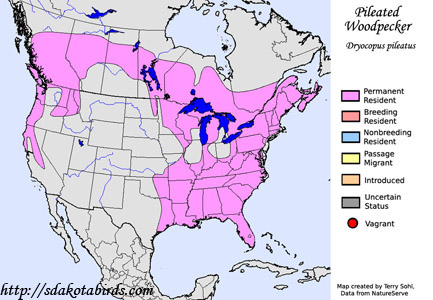According to his press agent, the creator of Woody Woodpecker, Walter Lantz, got the inspiration while in Sherwood Lake, California with his wife. Apparently, a noisy Pileated Woodpecker outside the cabin kept the couple awake at night. Woody shares many characteristics with the Pileated Woodpecker in terms of physical appearance as well as his characterstic laugh, which resembles the call of the Pileated Woodpecker! (If you've never heard the Woody Woodpecker's laugh, watch the video below!)
 |
| Pileated Woodpecker Range Map. |
Pileated Woodpeckers are the biggest woodpeckers in North America being about 16 to 19 inches tall - as big as a crow. The bird is mainly black with a red crest (the red feathers on top of its head) with a white line down the sides of its throat. In flight, the wings show white. Adult males also have a red line from the bill to the throat, but on adult females it is black.The only North American birds of similar coloring and size are the Ivory-billed Woodpecker and the Imperial Woodpecker (of the Southeastern US and Mexico respectively), but those two birds are extremely rare, if not extinct. Its pecking, or drumming, can be very loud and often sounds as if someone were striking a tree with a hammer.
 Pileated Woodpeckers typically live in thick forests near rivers or lakes. We can often see these birds in the woods around camp! Their habitat reaches from the Eastern-Middle United States, across Canada, to parts of the Western United States along the Pacific coast. The bird prefers large, mature hardwood trees. Usually, it will chip out a large hole in the cavity of a dead tree for its large nest. Sometimes, the hole gets so large it can cause a small tree to break in half, and there are typically multiple entrances to nest holes. Once the brood is raised the hole is abandoned, and each year a new hole/nest is created. Can't create nest in the same hole twice... that's just silly! Luckily, the abandoned holes become home to song birds, owls or other animals such as raccoon.
Pileated Woodpeckers typically live in thick forests near rivers or lakes. We can often see these birds in the woods around camp! Their habitat reaches from the Eastern-Middle United States, across Canada, to parts of the Western United States along the Pacific coast. The bird prefers large, mature hardwood trees. Usually, it will chip out a large hole in the cavity of a dead tree for its large nest. Sometimes, the hole gets so large it can cause a small tree to break in half, and there are typically multiple entrances to nest holes. Once the brood is raised the hole is abandoned, and each year a new hole/nest is created. Can't create nest in the same hole twice... that's just silly! Luckily, the abandoned holes become home to song birds, owls or other animals such as raccoon.
A Pileated Woodpecker pair stays together in its territory all year round. Pileated Woodpeckers are non-migratory species. It will defend its territory in all seasons. When clashing with unwelcome guests, the birds engage in chasing, calling, striking with the wings and jabbing with the bill. Drumming (pecking) is most commonly used to proclaim its territory Hollow trees are used to make the loudest sound possible.
Last fact: The oldest known Pileated Woodpecker was 12 years and 11 months old.

No comments:
Post a Comment